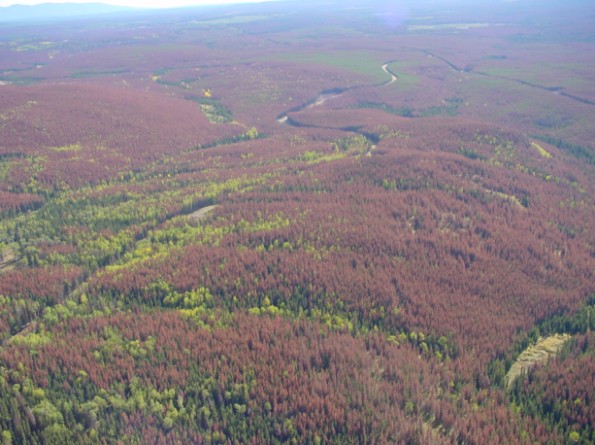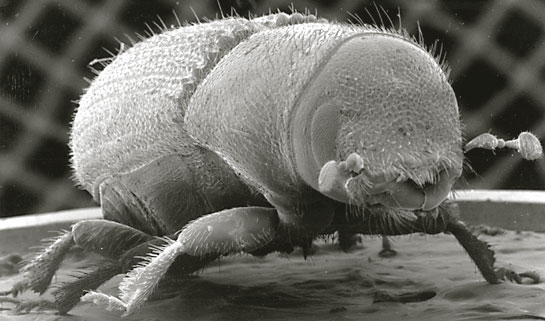
transition

myvalleysun.com
New Ideas About Life and Living in the Okanagan

Detecting the Beetle
Trees undergoing attack by the mountain pine beetle are first detectable only from the ground, and identification of symptoms requires close examination of trees. Infested trees can be detected through crown and external symptoms. The first signs are boring dust and resin on the bark associated with the attacking adults, but the mountain pine beetle can only be positively identified (and the success of an attack can only be positively determined) by looking under the bark.
At low (endemic) populations the mountain pine beetle survives in weakened or stressed trees. As populations increase or more trees become stressed because of drought or other causes, the population may quickly increase and spread. Healthy trees are then attacked and huge areas of mature pine stands may be threatened or killed. Warm summers and mild winters play a role in both insect survival and the continuation and intensification of an outbreak. Adverse weather conditions (winter low of -40°C or high winds during dispersal period) can reduce the beetle populations and slow the spread, but insect populations may recover (not the individual insects) and resume their attack on otherwise healthy forests.
Accumulations of pitch or sawdust are conspicuous around entrance holes bored into the bark of trees by adult beetles from mid-July to early September. Sawdust is quickly blown or washed away, but abundant pitch tubes may remain for more than a year after attack. Pitch tubes may be much less evident on trees under severe drought stress prior to attack. During the fall and winter after attack, woodpeckers feed on bark- and wood-boring insects on infested trees. Trunks of trees foraged on by woodpeckers are easily visible as much bark is stripped off and bark fragments accumulate in piles on the ground at the base of trees. Removal of bark from infested trees reveals adult egg galleries, larval feeding galleries, and one or more life stages (eggs, larvae, pupae, adults), depending on the time since attack. Egg galleries are 10–41 cm (average, 28 cm) long, oriented vertically on the stem, and have a short curved or diagonal section at the bottom. Grayish blue staining of sapwood, caused by colonization of ray parenchyma cells by blue stain fungi transmitted by adult beetles, provides a conspicuous symptom shortly after successful attack. Various fungal fruiting structures (such as synnemata and perithecia) and mycelia of blue stain fungi and other fungi are often evident in beetle galleries and pupal chambers.
Tree foliage begins to dry out as soon as the conduction of water up the tree is interrupted. As a result, the colour of the foliage on infested trees gradually changes from bright to dull green. This early symptom in the lower crown will often become visible 2-3 months after attack. However, more distinct colour changes occur during the onset of the growing season the spring following attack when tree foliage turns brick red. The needles of infested trees first turn a faint yellow and then a reddish brown by late summer, which allows easy detection; however, by the time trees prominently display these symptoms, they are typically vacated by the mountain pine beetle, which has moved on to attack other trees. With time, retained foliage colour becomes more dull, and most of the foliage drops in 2-3 years; this will vary from species to species and with weather conditions.
These rapid and distinct colour changes are used to schedule aerial mapping of recently attacked trees.
The mountain pine beetle has a life cycle that normally lasts one year. In late summer, the adults emerge from the trees in which they fed and developed from, and they fly off in search of new host trees.
The females bore holes into the trees waiting for males to come to them. The females bore vertical galleries just under the bark, in which they lay their eggs. The larvae that emerge from the eggs spend the winter feeding under the bark. Adult emergence takes place between July and September.
The mountain pine beetle life cycle has consumed a vast forest in British Columbia the size of New Brunswick and now the beetle has spread to lodgepole pine forests, and jack pine forests in Alberta.
Now University of Alberta researchers are closing in on developing an effective bait to get ahead of the destructive spread of mountain pine beetle. Nadir Erbilgin, associate professor and Canada Research Chair in Forest Entomology in the U of A's Department of Renewable Resources, has been investigating pheromones -- airborne chemical compounds that trigger a social response among individuals of the same species -- emitted by the pest in North America's lodgepole and jack pine forests.
The compounds are providing insight into how the beetles swarm in destructive numbers in the Canadian boreal forests. The mountain pine beetle has killed ponderosa pine and lodgepole pine forests in the Western United States, British Columbia, the Northwest Territories and Alberta and, according to other U of A research, could spread east to the Maritimes.
Newer to the beetle's list is the jack pine tree, and Erbilgin's research focuses on developing a bait that can be potentially used to monitor beetle activity specifically in jack pine forests in Alberta and other provinces. Traps with high numbers of beetle catches could indicate the levels of beetle population at a particular site.
"That information may help forest managers decide where to focus their beetle containment efforts," Erbilgin said.
The eventual goal is to develop a bait for use in a provincial "trap tree" program, in which visual and chemical cues would combine to attract high numbers of beetles. Trap trees are used to concentrate and contain the local beetle population on certain trees in Alberta. The infested trees are then used to assess the beetle population level and removed, along with the beetles.
"The mountain pine beetle is the most damaging forest insect in North America, and climate change has allowed the current epidemic to spread from lodgepole pine to jack pine, a tree species that was thought to be unsuitable for beetle survival in Alberta."
In fact, the beetle has attacked large swaths of jack pine in eastern Alberta close to the Saskatchewan border, Erbilgin noted.
Although the mountain pine beetle has many natural enemies including insect predators, parasitoids, and woodpeckers, these do not have sufficient impact on incipient and outbreak populations to exert effective control. Some people are saying they need to be trapped…
Erbilgin and his team, which includes associate professor Maya Evenden of the Department of Biological Sciences and several U of A graduate students, spent the summers of 2011 and 2012 testing the efficiency of a pheromone bait "that is showing promise," he said. The bait, tested in Grande Prairie lodgepole forests, works by attracting the beetles to traps.
Alberta field trials will continue in the summer of 2014, and the hope is to have an effective product developed for use within the next few years.
The U of A team's work is focused on fine-tuning baits currently being used in jack pine forests, in an effort to get ahead of beetle infestations. "Right now we don't know how efficient currently available commercial baits will be in catching beetles in jack pine forest, as they were developed to catch the beetle in lodgepole pine forests," Erbilgin said. Because the trees differ in their chemistry relating to beetle attraction and colonization, differences in beetle responses are to be expected, he added.
"Pheromones are essential for the mountain pine beetle to be able to spread and thrive, so we wanted to explore how we might use that to stop them," Erbilgin said. The chemical compounds play a key role in the insect's ability to find a mate and to overcome tree defences.
The U of A study, published recently in New Phytologist, investigated the tree chemical compounds that play critical roles in the beetle's pheromone production and attraction in both their established lodgepole pine host and in the newer jack pine host.
The study revealed that the beetles emit the same pheromones from both tree species, but researchers found that the females in the jack pine tree emitted more trans-verbenol, a pheromone that initiates the beetle aggregation on host trees. Females lead the first attacks on trees, while sending out pheromone signals for more beetles to join the aggregation.
"Without this initial chemical signalling, the beetles couldn't aggregate on the same tree," Erbilgin noted.
Beetle attacks also induce a release of a volatile tree chemical, 3-carene. Field tests conducted by Erbilgin and his team showed that when 3-carene was added to a mixture mimicking the aggregation pheromone, beetle capture in traps increased.
Understanding the role of pheromones in beetle invasion also allows for quicker monitoring of the insect's activities in jack pine forests, Erbilgin said. "This eliminates the one- to two-year gap in diagnosing beetle-killed stands, which don't show up until the dead foliage turns red."
Journal Reference:
1.Nadir Erbilgin, Cary Ma, Caroline Whitehouse, Bin Shan, Ahmed Najar, Maya Evenden. Chemical similarity between historical and novel host plants promotes range and host expansion of the mountain pine beetle in a naïve host ecosystem. New Phytologist, 2013; DOI: 10.1111/nph.12573
Outsmarting the aggressive Mountain Pine Beetle
bug
update
A "Trap Program" is being developed to stop the spread of the Mountain Pine Beetle.

New Ideas About Life and Living in the Okanagan
We update this website on a regular basis.